
Original Link: https://www.anandtech.com/show/2808
Intel X25-M G2: Dissected and Performance Preview
by Anand Lal Shimpi on July 22, 2009 6:00 PM EST- Posted in
- Storage
Be sure to read our latest SSD article: The SSD Relapse for an updated look at the SSD market.
Earlier today the FedEx man dropped off a box with this in it:
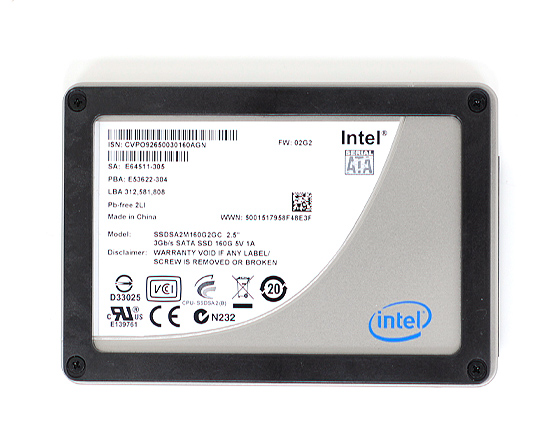
That's the new X25-M G2 I wrote about yesterday, which features a slightly improved controller and 34nm NAND flash. Im hard at work on a full review but I thought I'd share some preliminary data with you all.
As I mentioned yesterday, the new drive has a silver enclosure. Intel says the new enclosure is cheaper than the old black one:
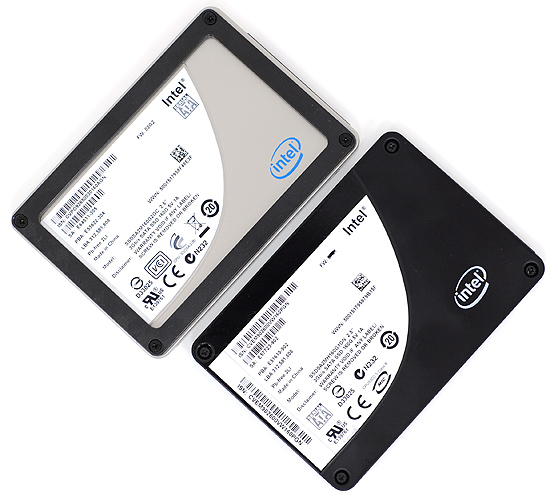
The X25-M G2 (top) vs. the X25-M G1 (bottom)
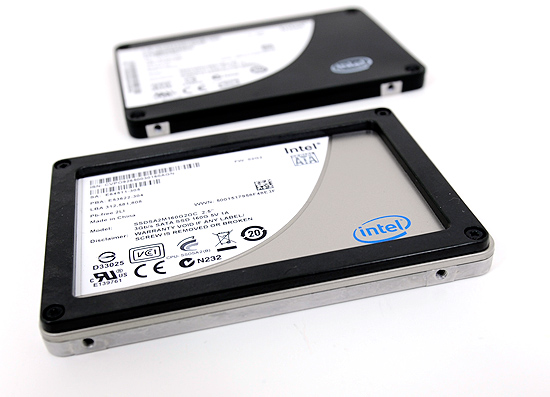
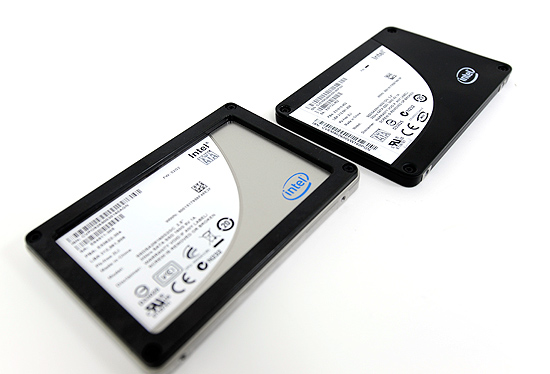
Our sample also shipped with a plastic spacer so the drive can be used in 9.5mm 2.5" bays as well as 7mm bays by removing the spacer.

Inside the Drive: 2x Density Flash and more DRAM
We of course had to pop the top and see what's changed inside the drive. As soon as you get the cover off you realize exactly what Intel has done:
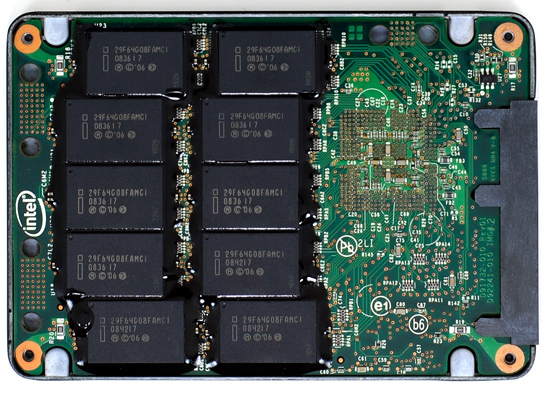
The old X25-M G1
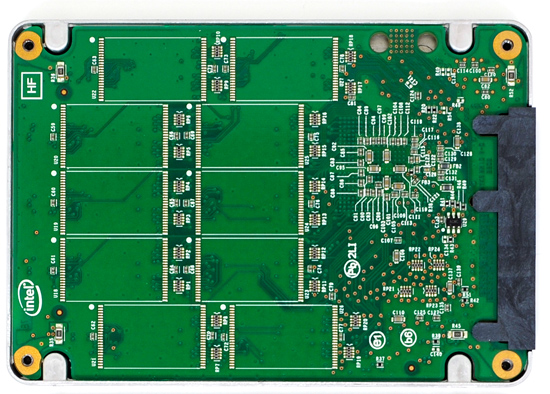
The new X25-M G2
Both of these are 160GB drives; Intel is now using 16GB flash packages instead of 8GB packages from the original drive. Once 34nm production really ramps up, Intel could outfit the back of the PCB with 10 more chips and deliver a 320GB drive. I wouldn't expect that anytime soon though.
The controller-side of the PCB looks similar, although Intel stopped using the black goup they used to cover all of the NAND flash contacts of the original drive. I wonder if that was a manufacturing measure or something to prevent competitors from hooking up an oscilloscope to the pins on the flash and reverse engineering the controller...
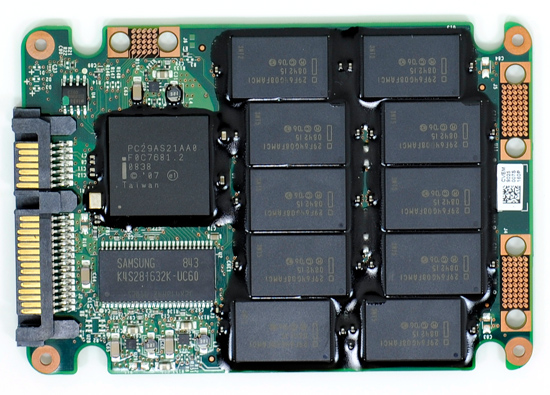
The old X25-M G1
It could have also been a thermal expansion thing; Microsoft had to use a similar approach to help prevent Xbox 360s from red-ringing.
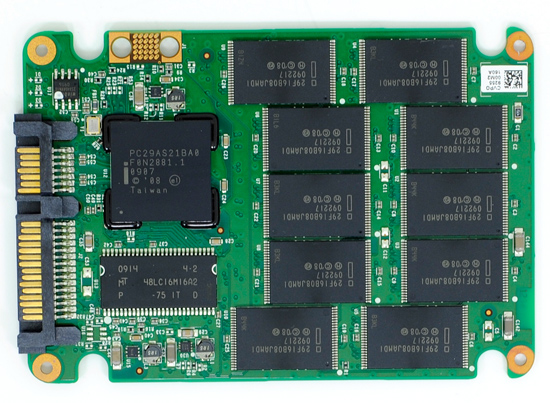
The new X25-M G2
The new controller comes in the same physical package as the old one:
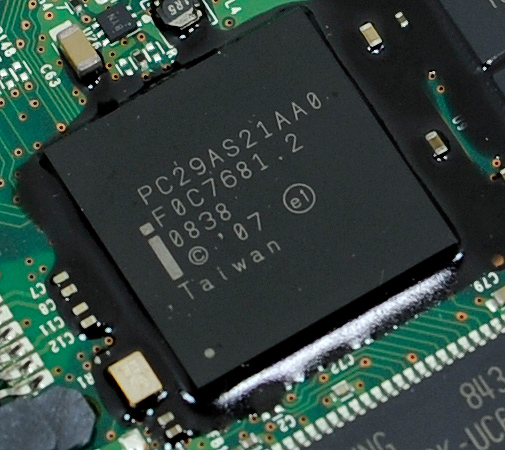
The old controller
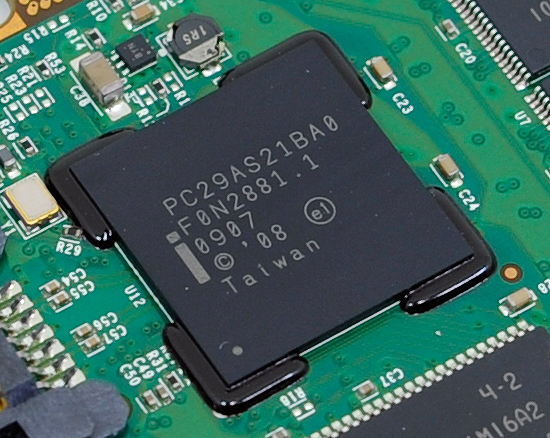
The new controller
The part numbers have changed. The old one was an Intel PC29AS21AA0, the new one is an Intel PC29AS21BA0.
Intel also swapped vendors for the X25-M's on-board DRAM. The old 160GB drive used a 16MB Samsung 166MHz SDRAM (CAS3):
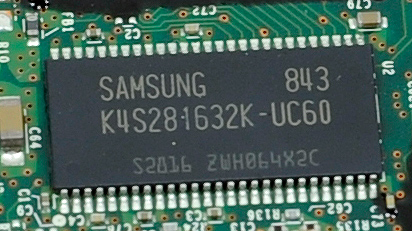
Goodbye Samsung
The new 160GB G2 drive uses a 32MB Micron 133MHz SDRAM (CAS3):
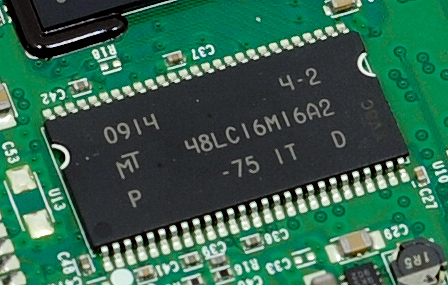
Hello Micron
DRAM size went up, while clock speed went down. I wonder what Intel is doing with all of that additional DRAM on the new drives? Hmm...
The Competitors
For the most part, Intel doesn't let anyone else manufacture drives using its controller (the lone exception being Kingston). Indilinx and Samsung however both sell their controllers and designs to many other vendors, who then repackage them and sell them as their own SSDs. The table below is a decoder ring of the drives I tested and their equivalents in the marketplace:
| Drive | Controller | The Same As |
| Patriot Torqx | Indilinx Barefoot (MLC) | Corsair Extreme Series X128 |
| OCZ Agility | Indilinx Barefoot (non Samsung MLC) | N/A |
| OCZ Vertex EX | Indilinx Barefoot (SLC) | SuperTalent UltraDrive LE |
| OCZ Summit | Samsung RBB (MLC) | Corsair Performance Series P256 |
While I used the Torqx from Patriot as my Indilinx MLC drive, it's the same drive and uses the same firmware as OCZ's famed Vertex drive or the new Cosair Extreme Series SSD. The only exception on this list is the OCZ Agility. The Agility uses the same Barefoot controller as the Torqx, Vertex, UltraDrive ME and Corsair X series, but it uses non-Samsung flash memory to lower cost. The Agility currently ships with either Toshiba or Intel flash, but should be roughly the same performance as the other Indilinx MLC drives.
I included the SLC drives as a reference point, but for desktop use they are overkill. Not only is their firmware not optimized for desktop usage patterns, but they are far more expensive on a cost-per-GB basis.
All of the drives used the latest firmwares at the time of publication.
The Pricing
The table below is the pricing comparison I went through yesterday:
| Drive | NAND Capacity | Cost per GB | Price |
| Intel X25-M (34nm) | 80GB | $2.81 | $225 |
| Intel X25-M (34nm) | 160GB | $2.75 | $440 |
| OCZ Vertex (Indilinx) | 64GB | $3.41 | $218 |
| OCZ Vertex (Indilinx) | 128GB | $3.00 | $385 |
| Patriot Torqx (Indilinx) | 64GB | $3.48 | $223 |
| Patriot Torqx (Indilinx) | 128GB | $2.85 | $365 |
| OCZ Agility (Indilinx, non-Samsung Flash) | 64GB | $2.77 | $177 |
| OCZ Agility (Indilinx, non-Samsung Flash) | 128GB | $2.57 | $329 |
| OCZ Summit (Samsung) | 128GB | $3.04 | $389 |
The new 34nm drives were supposed to start shipping yesterday, but I've yet to see them available online. It's also worth mentioning that Intel doesn't give out street pricing, only 1,000 unit pricing. The street price of the X25-M G2 drives could be higher at first, similar to what we saw with the 1st gen drives, eventually leveling off below the 1Ku pricing.
The Performance
There are four basic pillars to SSD performance that I like to look at: random read, random write, sequential read and sequential write speed. A good SSD must be strong in all four categories, but some are more noticeable than others. Random read and write speed, particularly of small files (e.g. 4KB) are normally what make our desktop hard drives feel so slow. These random operations are everything from file and table updates to search queries and loading applications; they aren't random over the entire space of the disk but they are random enough to bring conventional hard drives to their knees.
Sequential read/write speed is what you encounter when copying large files. How quickly you can move a Blu-ray image around is determined by these values. I've run all four tests on these drives using IOMeter. I also test all SSDs in a completely used scenario where each LBA/page has been touched, at some point, with valid data. Brand new, out of the box, performance will be greater but not over the life of the drive. If you want to know more about why this is and how I test, I suggest consulting The SSD Anthology.
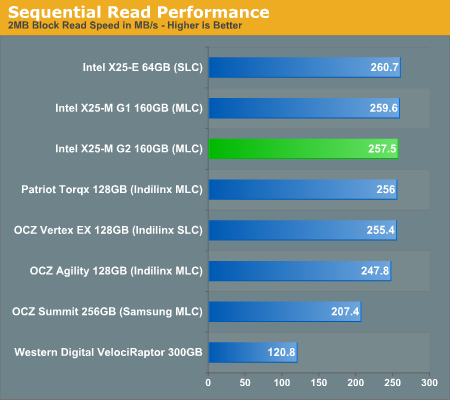
Sequential read performance is basically maxed out for these drives; we're bottlenecked by the SATA bus at this point (300MB/s minus some overhead). We won't see sequential read performance improve until the 6Gbps SATA protocol starts appearing in controllers. The X25-M G2 is basically the same speed as the previous gen here.
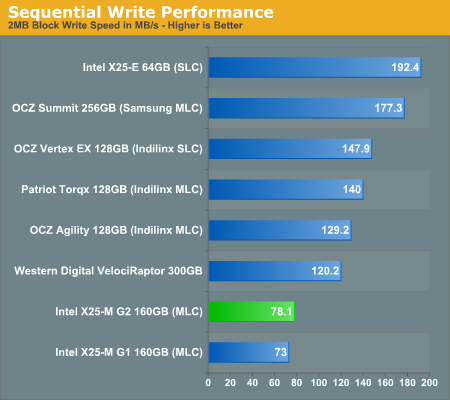
Sequential write performance has always been a bottleneck on the Intel drives. There's a small 7% performance improvement from the new drive, but it's still much slower than any other MLC drive in its class. Pushing higher speeds isn't an issue for the controller as the SLC X25-E actually posts our fastest numbers here.
While I don't believe that 70MB/s write speeds are terrible, Intel does need to think about improving performance here because the competition is already far better. The more important values are still random read/write performance, but sequential write speed is an area that Intel continues to lag behind in.

The real strength of the Intel drives is in its random, small file, read/write performance. Here we see a 10% improvement in random read performance over the 1st gen drives, putting the new X25-M ahead of even the X25-E. Now there are obvious lifespan benefits you get from an SLC drive that the G2 can't match, but for a desktop user this thing is even better than the X25-E.
None of the competitors can touch the X25-M here; Intel is 50% faster than the closest MLC contender. It's tough to read but the WD VelociRaptor scores a 0.68MB/s score here.
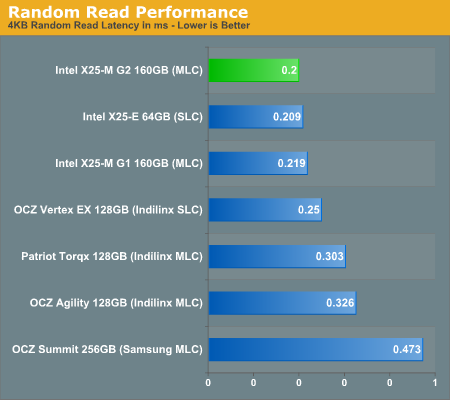
These are the same results as above but I'm reporting average latency instead of average transfer rate. It gives you a bit of the idea of the scale of performance here. I had to remove the WD VelociRaptor because its read latency threw the chart's scale off, it averaged 17.3 ms here.
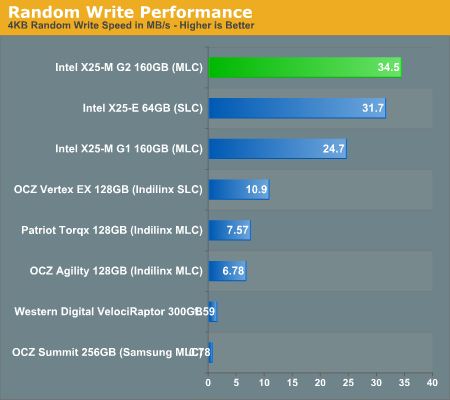
And the X25-M G2's true strength: random write performance. Once again, we're faster than the X25-E and nearly 40% faster than the X25-M G1. None of the Indilinx or Samsung drives can touch Intel here.
The Samsung RBB controller does not seem to like worst-case random writes on a well used drive, it's actually slower than the VelociRaptor here. This is what I've seen in my earlier investigations as well. It actually helps explain why the older Samsung based SSDs in Apple notebooks never really felt all that fast.
Final Words...for now
The X25-M G2 appears to be everything Intel said it would be. It's anywhere from 0 - 40% faster than the 1st gen drive in these low level tests. I would expect to see a 0 - 10% improvement in the real world depending on applications, but that's what I'm off to test next.







